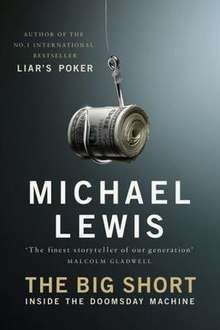The Big Short
The Big Short: Inside the Doomsday Machine is a non-fiction book by Michael Lewis about the build-up of the United States housing bubble during the 2000s. The book was released on March 15, 2010, by W. W. Norton & Company. It spent 28 weeks on The New York Times best-seller list, and was the basis for the 2015 film of the same name.
 Hardcover edition | |
| Author | Michael Lewis |
|---|---|
| Country | United States |
| Language | English |
| Genre | Finance |
| Publisher | W. W. Norton & Company |
Publication date | March 15, 2010 |
| Media type | Print (hardcover) |
| Pages | 320 pp. |
| ISBN | 0-393-07223-1 |
| OCLC | 567188407 |
| LC Class | HC106.83 L5 2010 |
| Preceded by | Home Game |
| Followed by | Boomerang |
Summary
The Big Short describes several of the main players in the creation of the credit default swap market that sought to bet against the collateralized debt obligation (CDO) bubble and thus ended up profiting from the financial crisis of 2007–08. The book also highlights the eccentric nature of the type of person who bets against the market or goes against the grain.
The work follows people who believed the bubble was going to burst, like Meredith Whitney, who predicted the demise of Citigroup and Bear Stearns; Steve Eisman, an outspoken hedge fund manager; Greg Lippmann, a Deutsche Bank trader; Eugene Xu, a quantitative analyst who created the first CDO market by matching buyers and sellers; the founders of Cornwall Capital, who started a hedge fund in their garage with $110,000 and built it into $120 million when the market crashed; and Michael Burry, an ex-neurologist who created Scion Capital.[1]
The book also highlights some people involved in the biggest losses created by the market crash: like Merrill's $300 million mezzanine CDO manager Wing Chau; Howie Hubler, known as the person who lost $9 billion in one trade, the second largest single loss in history;[2] and Joseph Cassano's AIG Financial Products, which suffered over $99 billion in losses.[3]
Reception
The book was shortlisted for the 2010 Financial Times and Goldman Sachs Business Book of the Year Award. It spent 28 weeks on The New York Times' non-fiction bestseller list.[4]
It also received the 2011 Robert F. Kennedy Center for Justice and Human Rights Book Award.[5]
Film
Paramount acquired the rights to The Big Short: Inside the Doomsday Machine in 2013. On March 24, 2014, it was announced that Adam McKay would direct the adaptation.[6] On January 13, 2015, Variety reported that Brad Pitt, Christian Bale and Ryan Gosling were set to star in the film, and Pitt would produce the film with McKay and Dede Gardner. Steve Carell then joined.[7] Plan B Entertainment financed the film with Paramount handling the distribution rights.
Production started on March 23, 2015[8] in New Orleans, LA.[9] The film was released on December 11, 2015, and was met with critical acclaim, winning the Academy Award for Best Adapted Screenplay, as well as receiving a nomination for the Academy Award for Best Picture.
See also
References
- Lewis, Michael, Betting on the Blind Side", Vanity Fair, April 2010
- "Stories on Howie Hubler" Archived August 23, 2010, at the Wayback Machine, The New York Observer
- "U.S. offers more funds to help fraught AIG: $30 billion more in loans; $61.7 billion lost in the fourth quarter", NBC News, March 2, 2009.
- "The New York Times Bestseller List" (PDF). The New York Times. October 10, 2010. Retrieved January 19, 2016.
- "RFK Center Book Awards".
- Dave McNary (March 24, 2014). "'Anchorman's' Adam McKay Boards Financial Drama". Variety. Retrieved January 14, 2015.
- Borys Kit (January 14, 2015). "Steve Carell in Talks to Join Christian Bale, Ryan Gosling in 'The Big Short'". The Hollywood Reporter. Retrieved January 14, 2015.
- Justin Kroll (January 13, 2015). "Brad Pitt, Christian Bale and Ryan Gosling to Star in Financial Drama 'The Big Short' (EXCLUSIVE)". Variety. Retrieved January 14, 2015.
- "Brad Pitt Film "The Big Short" Casting Call in LA". Auditions Free. March 5, 2015. Retrieved March 6, 2015.
External links
| Wikiquote has quotations related to: The Big Short |
- The Big Short, at W. W. Norton (official book site)
- 'Shorting our Future', a review of The Big Short in The Oxonian Review